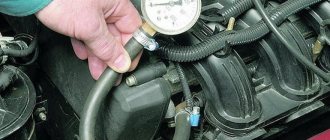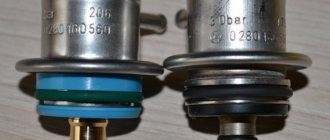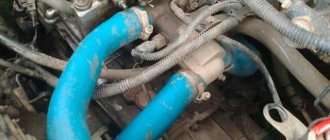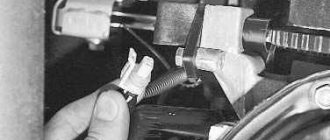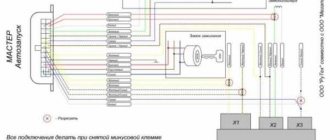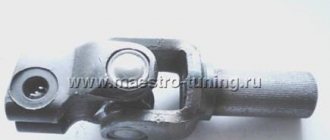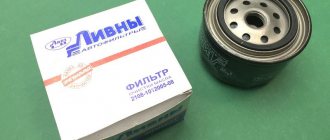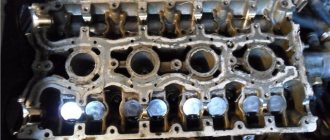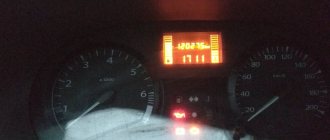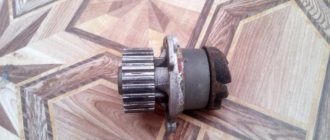03 February 2016 Lada.Online 79 916 1
Is the car jerking, loss of agility or the engine is difficult to start? One of the reasons for such malfunctions may be related to fuel pressure. Let's look at the instructions for measuring pressure in the fuel rail, as well as features that may arise during this activity.
Checking the fuel pressure is carried out similarly for all Lada cars (Granta, Kalina, Priora, Largus, Vesta, Niva 4x4 and XRAY), because All these models have the same type of engines.
In what cases is it necessary to relieve pressure?
The pressure in the fuel system must be relieved each time before removing or replacing system components. For example, when removing a ramp or replacing a fuel filter. Otherwise, there is a high chance that gasoline may spill on you. This operation is necessary if depressurization of the system is required to remove certain of its elements and carry out repair work. The pressure needs to be checked if it is necessary to determine the functionality of the electric fuel pump, or to identify a malfunction of the fuel system pressure regulator.
What are the consequences of malfunctions in the operation of RDTs?
Over time, the engine starts more and more poorly. Fuel begins to come out of the cracks, which leads to a strong increase in its consumption. When the pressure changes unevenly, the dynamics of movement are disrupted, surges occur, and the car jerks during acceleration.
Is it possible to repair a failed part? In most cases, no, you have to completely change it. Repair units are almost always non-separable. Some experts suggest repairing the component, but this is dangerous. It is better to buy a new regulator - fortunately, it is inexpensive.
Determining violations in the operation of RTDs is not a very difficult task, which can be handled independently. Remember that this part of the machine needs to be checked periodically. By detecting the problem in time, you will protect important car components from rapid wear.
Characteristic symptoms of fuel pressure regulator malfunctions
By what signs can you determine that an RDT is not working:
- the engine is very difficult to start, you need to turn the starter for a long time and at the same time keep the gas pedal pressed in order for the engine to start;
- The engine idles unsteadily or the speed is very low, the engine often stalls. At the same time, it does not gain power at all; when trying to accelerate, it results in a deep failure;
- The spam engine changes speed sharply, this is especially noticeable at idle:
- Fuel is leaking from the fuel hoses. Attempts to tighten and replace clamps and replace hoses do not help.
How to check the fuel pressure regulator for serviceability
The fuel pressure regulator is not an electrical sensor and cannot be checked using instruments. It should also be taken into account that the RDT cannot be disassembled or repaired. Someone writes that the fuel check valve can be repaired. I would like to see what it looks like and where you can buy a repair kit. Typically, RTDs are inexpensive, and even for that reason they would not be worth repairing if they were repairable.
Mechanical fuel pump VAZ-2110 - characteristics and design
This type of mechanism is used exclusively on cars with carburetor engines. This VAZ-2110 fuel pump has its own mechanical drive from the camshaft, and it is located on the internal combustion engine.
By its design, this element is one of the types of piston and includes the following parts:
- Two-piece body with a lid on top.
- Diaphragm. It is installed between the lower and upper parts of the housing.
- Return spring.
- Stock. It is rigidly connected to the diaphragm.
- Discharge and suction valve. It is located at the top of the pump.
- Mechanical drive.
- Mesh filter.
The drive of this device, as we said earlier, is carried out from the camshaft eccentric. When this element rotates, the part moves the rod with the diaphragm down, and the spring force is overcome. The volume of space above it increases, and gasoline, due to the resulting vacuum, enters the pump through a separate valve from the gas tank. The discharge valve is closed.
The main operating mechanism of the pump is the diaphragm. It consists of two membranes, between each of which there is its own gasket. The diaphragm is connected to the rod. The latter interacts with the mechanical drive parts. There are different pump drive schemes. For example, domestic “tens” use a design that consists of a pusher and a lever with a balancer. Foreign cars use their own technology with a double-arm “rocker arm”.
https://arenda-pieter.ru/drugoe/shema-toplivnoj-sistemy-priora.html https://mazda22.ru/servis/toplivnaya-sistema-priora-inzhektor-17.html
About pressure drop
When it comes to pressure problems, it looks something like this:
- when the engine is running in idle mode, 2.8 atm is displayed, stable pressure, builds up quickly;
- after turning off the engine, the pressure instantly drops to 2.5 atm;
- after a minute or two it drops again to 2 atm;
- after 10 minutes – 1.6 atm.
New Lada: Lada Kalina engine heats up at idle: photo, video
Why does the pressure drop? There are definitely problems in the fuel system, and, as a rule, this is due to the fact that the check valve of the pump does not hold. This is why the pressure drops so quickly after the ignition is turned off.
Fuel pressure control
https://www.youtube.com/watch?v=GIsZBd1U7Dc
In extreme cases, it is possible that the DDT pressure sensor fails. Methods for checking both options are given below.
Is the pressure sensor working?
- Remove the tube from the pressure regulator.
- Look at the indicators on the pressure gauge scale. If they have not changed, then the regulator (sensor) is faulty. In normal condition, the needle should jump after turning off the DDT.
You can diagnose a check valve like this:
- pinch the return hose on the working engine;
- the pressure should jump again, this time even more than in the case of the sensor.
If the indicator does not increase when the return line is compressed, but the pressure level in the system is normal, this can only mean one thing - gasoline is not flowing through the fuel drain line. Or there is a leak in the fuel supply pipe.
Often a slow increase in pressure is caused by a clogged coarse mesh in the pump. The mesh needs to be cleaned or better replaced with a new one.
The fuel pump can also cause a drop in pressure in the system. It makes sense to diagnose it for normal functioning. Many people take it and simply measure the pressure directly from it. The pressure gauge should show high values, within 6 atm. If not, then the pump is most likely faulty.
In general, the actual functioning of the pump is confirmed by a buzzing sound when the ignition is turned on. If the fuel pump is installed in an open place, its operation can be checked by touching the housing (vibration should be felt).
If the pump does not work, then you must first test the fuse or relay responsible for its operation.
Important to remember
When you check the fuel pressure with the ignition on, note that after the ignition is turned off, the pressure in the rail drops to 0.7-1 atmosphere and remains at this level. If it drops to 0, the problem is in the fuel pressure regulator.
.
Try increasing the number of revolutions to 3000 - if the pressure gauge needle does not stay constant, but falls, this may mean that it is time to change the fuel pump
.
If the pressure builds up for a very long time or is lower than required, the fuel filter, fuel pump filter or fuel line may be clogged.
I hope you found it interesting and will take note of this. Subscribe to the channel and give it a thumbs up to see even more interesting articles on automotive topics in your feed every day.
Source
How to relieve pressure in the fuel system of a Priora
- To the beginning of the forum
- Forum Rules
- Old design
- FAQ
- Search
- Users
Damn, unscrew this cap, press the nipple, gasoline will flow out a little from the ramp and the pressure will be 0
I think it will still become equal to atmospheric
Damn, unscrew this cap, press the nipple, gasoline will flow out a little from the ramp and the pressure will be 0
Just don’t forget to use a cloth, otherwise you’ll end up on the exhaust manifold.
Regards, Mikhail
People, what the hell are you doing?! After 5 minutes the pressure drops to atmospheric pressure. If the fuel pump is not working, the pressure in the system will not hold for long.
Damn, unscrew this cap, press the nipple, gasoline will flow out a little from the ramp and the pressure will be 0
Have you tried doing this yourself? How much is a little? Pranksters. If you do it wisely, then you need to remove the connector from the BN, and start it, wait until the flask stalls, then turn on the starter again. And unscrew the gas tank cap to release pressure from the return line.
I turned it off, stood for 10-15 minutes, opened the gas tank cap and can close it. All. Atmospheric pressure loss
Just don’t forget to use a cloth, otherwise you’ll end up on the exhaust manifold.
Have you tried doing this yourself? How much is a little? Pranksters. If you do it wisely, then you need to remove the connector from the BN, and start it, wait until the flask stalls, then turn on the starter again. And unscrew the gas tank cap to release pressure from the return line.
I do this all the time, it’s much easier and simpler than taking off the connector and screwing up the engine at 500 rpm. You bleed the air from the tank, release the pressure through the nipple and you're done.
Source
How to relieve pressure in the fuel system?
Relieving pressure in the fuel system is a simple task and does not take much time. You can perform the operation yourself. The algorithm for relieving pressure in the system is as follows: 1. Turn the car to neutral speed. 2. Secure the position of the machine with the parking brake lever. 3. Remove the rear sofa. 4. Disconnect the block with wires from the electric fuel pump. 5. Turn on the motor. Wait a while until the gasoline runs out and the engine stalls. 6. Start the engine again. Turn the starter for a few seconds. The pressure in the fuel line has been relieved.
How to measure the pressure in a car’s fuel rail yourself and why you need it
Checking the pressure in the fuel rail is a standard procedure in a long chain of diagnosing engine and fuel system malfunctions. Often this check is carried out in cases where the engine runs unevenly and there are dips during acceleration.
This is one of the mandatory check points if the car jerks during acceleration. I described this in the article “ Why does a car jerk during acceleration and acceleration?”
" Also, this diagnosis is performed in cases where the car has increased fuel consumption.
see also
“Peter - AT” INN 780703320484 OGRNIP 313784720500453
The Priora stopped driving as it should; when accelerating, it was as if they were holding the tail of the car; when it started moving, it failed. I exchanged consumables (spark plugs, coils, fuel pump, filter, DPZ, IRR, washed the injectors myself) I installed the pump from a known-good car - the same result. Later I got a fuel pressure gauge and took measurements
Method 3: Press down on the control valve
Another method to avoid spilling gasoline when releasing pressure is to operate the control valve. You need to take a tube, a bottle and a sharp object (an awl, a nail or a screwdriver). Sequencing:
- Unscrew the protective cap on the engine that covers the control valve;
- put a tube on the fitting;
- lower the free end of the hose into the bottle;
- pierce the hose near the fitting with a sharp object;
- Press the control valve spool with a screwdriver.
After dumping the fuel, the protective cap must be returned to its place.
There is another way to reduce pressure:
The gear lever is moved to neutral, and the handbrake is fixed. Then they dismantle the rear seats, disconnect the block from the fuel pump, start the engine and wait for it to stop. Now the pressure has been released, you can reattach the block.
There are several methods to relieve pressure in a vehicle, but each of them should only be used with a cold, idle engine. It should be remembered that even an hour after stopping the engine, the fuel in the system is under pressure. A natural decrease in pressure occurs within three to four hours after stopping the engine.
Source
Diagnostic instructions
The first step is to free access to the ramp and fitting installed at the end of the manifold. Remove elements that interfere with measurements - air duct, filter housing, crankcase ventilation pipe, etc. (the list of parts depends on the car model). Proceed to measuring, following the instructions:
- Unscrew the protective plastic cap from the diagnostic fitting on the ramp.
- Place a cut-off plastic container and use a cap to unscrew the spool valves to release the pressure previously pumped up by the pump. You can press the valve or turn the spool 2-3 turns.
- Place one end of the gasoline hose onto the pressure gauge fitting and secure with a clamp. Unscrew the spool from the manifold, pull the second end of the hose onto the pipe.
- Turn on the ignition, and the electric fuel pump will pump fuel into the system. Make sure there are no leaks at the joints of the diagnostic tool.
- Start the engine and record the fuel pressure in the rail using the pressure gauge.
Advice. It is better to take readings from the device twice - after turning on the ignition and starting the engine. If you notice a difference, you need to additionally check the regulator and fuel pump.
The pressure level in the fuel supply circuit depends on the design of the system. In cars where the RTD and the discharge tube - “return” - are located in the engine compartment, the pressure gauge should show 2.7 Bar. The upper and lower permissible limit is 2.7–3.0 Bar. If the measured values are outside the specified range, you should continue the diagnosis and find the cause of the problem.
